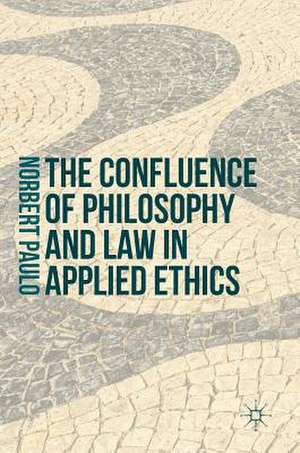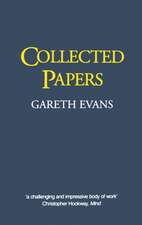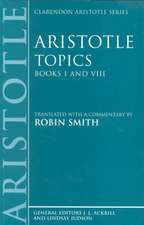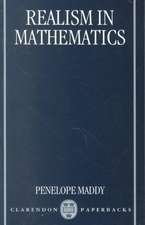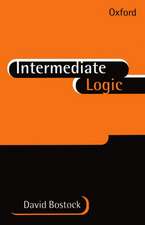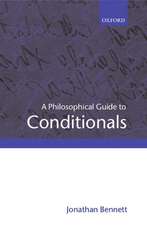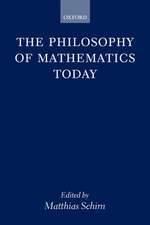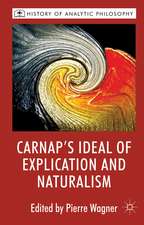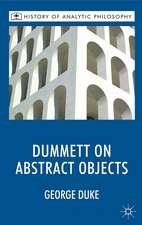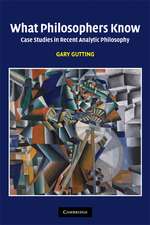The Confluence of Philosophy and Law in Applied Ethics
Autor Norbert Pauloen Limba Engleză Hardback – 10 iun 2016
The author first outlines methods as used in legal theory, focusing on deductive reasoning with statutes as well as analogical reasoning with precedent cases. He then examines three representative kinds of contemporary ethical theories, Beauchamp and Childress’s principlism, Jonsen and Toulmin’s casuistry, and two versions of consequentialism—Singer’s preference utilitarianism and Hooker’s rule-consequentialism—with regards to their methods. These examinations lead to the Morisprudence Model for methods in applied ethics.
Preț: 584.43 lei
Preț vechi: 687.56 lei
-15% Nou
Puncte Express: 877
Preț estimativ în valută:
111.83€ • 121.86$ • 94.23£
111.83€ • 121.86$ • 94.23£
Carte tipărită la comandă
Livrare economică 23 aprilie-07 mai
Preluare comenzi: 021 569.72.76
Specificații
ISBN-13: 9781137557339
ISBN-10: 1137557338
Pagini: 230
Ilustrații: VIII, 250 p. 3 illus.
Dimensiuni: 148 x 210 x 20 mm
Greutate: 0.43 kg
Ediția:1st ed. 2016
Editura: Palgrave Macmillan UK
Colecția Palgrave Macmillan
Locul publicării:London, United Kingdom
ISBN-10: 1137557338
Pagini: 230
Ilustrații: VIII, 250 p. 3 illus.
Dimensiuni: 148 x 210 x 20 mm
Greutate: 0.43 kg
Ediția:1st ed. 2016
Editura: Palgrave Macmillan UK
Colecția Palgrave Macmillan
Locul publicării:London, United Kingdom
Cuprins
PART I: ETHICS AND LAW.- 1 The Black-Box Problem.- METHODS.- OUTLINE.- 2 Ethics, Applied Ethics, and Law.- TERMINOLOGY: ETHICS AND MORALITY.- ETHICS, APPLIED ETHICS, BIOETHICS.- ETHICS AND LAW.- CONCLUSION.- PART II: METHODS IN LEGAL THEORY.- 3 Norms.- ABSTRACT AND GENERAL NORMS.- PRINCIPLES AND RULES.- Dworkin on Principles.- Principles as Optimization Requirements.- 4 Norm Application.- DEDUCTIVE STRUCTURE.- INTERPRETATION.- RULES OF INTERPRETATION.- Some Intricacies.- REASONING WITH PRECEDENTS.- Precedents.- What is binding?.- Strict binding force?.- ANALOGICAL REASONING.- Brewer’s Theory of Analogical Reasoning.- The sequence of processes.- CONCLUSION.- 5 Norm Development.- EXPANSIONS.- Supplementation.- Conflict of principles: proportionality test.- The four steps.- Critique.- Gap-Filling.- Distinguishing.- REVISIONS.- Overruling.- Correction of Mistakes.- NEW LEGISLATION.- CONCLUSION.- PART III: METHODS IN CONTEMPORARY ETHICAL THEORIES.- 6 Principlism.- THE STRUCTURE OF PRINCIPLISM.- Clusters of Principles and the Common Morality.- Principles and Rules.- Ideals, Virtues, and Rights.- PRINCIPLISM’s NORMATIVE CONTENT.- Respect for Autonomy.- Nonmaleficence.- Beneficence, Impartiality, and Moral Status.- Justice.- Relationship.- THEORY OF JUSTIFICATION.- METHODS.- Specification.- The importance of revisions and expansions.- Richardson’s definition.- Interpretation.- Abandoning specification.- Balancing.- The constraining conditions and proportionality.- Critique and alternatives.- CONCLUSION.- 7 Casuistry.- THE BASICS.- THE STRUCTURE OF CASUISTRY.- Morphology.- Taxonomy.- Kinetics.- CRITIQUE.- Cases do not speak forthemselves.- What rules the case?.- Importance of the Taxonomy.- The Role of Paradigms.- Arbitrary Kinetics.- Casuistry’s Conventionality.- A BETTER STRUCTURE FOR CAUSISTRY.- Rules: Maxims and Paradigms.- Application of Paradigms.- Overruling and Distinguishing Paradigms.- Analogical Reasoning.- CONCLUSION.- 8 Consequentialism.- PETER SINGER’s PREFERENCE UTILITARIANISM.- The Practice of Singer’s Theory.- BRAD HOOKER’s RULE-CONSEQUENTIALISM.- The Basic Theory.- Structure.- Impartiality, Reflective Equilibrium, and Pluralism.- Prima Facie Rules, Interpretation, and Conflicts.- Hooker on Euthanasia.- CONCLUSION.- 9 The Morisprudence Model for Applied Ethics.- DEDUCTIVE NORM APPLICATION.- APPLICATION AND DEVELOPMENT.- WHY THE MORISPRIDENCE MODEL?.- Notes.- Bibliography.- Index
Notă biografică
Norbert Paulo is a lecturer in practical philosophy at the University of Salzburg, Austria. He holds a PhD in philosophy from Hamburg University, Germany, where he studied both philosophy and law. His primary research concerns applied ethics, ethical theory, philosophy of law, and empirical ethics.
Textul de pe ultima copertă
The law serves a function that is not often taken seriously enough by ethicists, namely practicability. A consequence of practicability is that law requires elaborated and explicit methodologies that determine how to do things with norms. This consequence forms the core idea behind this book, which employs methods from legal theory to inform and examine debates on methodology in applied ethics, particularly bioethics. It is argued that almost all legal methods have counterparts in applied ethics, which indicates that much can be gained from comparative study of the two.
The author first outlines methods as used in legal theory, focusing on deductive reasoning with statutes as well as analogical reasoning with precedent cases. He then examines three representative kinds of contemporary ethical theories, Beauchamp and Childress’s principlism, Jonsen and Toulmin’s casuistry, and two versions of consequentialism—Singer’s preference utilitarianism and Hooker’s rule-consequentialism—with regards to their methods. These examinations lead to the Morisprudence Model for methods in applied ethics.
The author first outlines methods as used in legal theory, focusing on deductive reasoning with statutes as well as analogical reasoning with precedent cases. He then examines three representative kinds of contemporary ethical theories, Beauchamp and Childress’s principlism, Jonsen and Toulmin’s casuistry, and two versions of consequentialism—Singer’s preference utilitarianism and Hooker’s rule-consequentialism—with regards to their methods. These examinations lead to the Morisprudence Model for methods in applied ethics.
